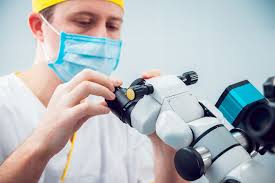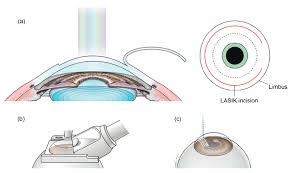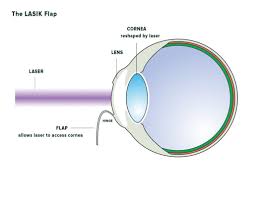Table of Contents
ToggleYes, you can deadlift after LASIK, but you need to wait for a specific recovery period and follow your doctor’s guidelines.
Jumping back into your fitness routine too early can jeopardise your healing process and the success of your LASIK procedure.
For fitness enthusiasts and athletes, managing the recovery period post-LASIK can feel like a challenge. If your workout routine includes deadlifting, it’s important to understand how LASIK impacts your eyes and what precautions you need to take during your recovery. This guide covers everything you need to know about safely resuming deadlifts (and other gym activities) after LASIK, helping you protect your vision while staying on track with your fitness goals.
Understanding LASIK and the Recovery Process
LASIK (Laser-Assisted in Situ Keratomileusis) is one of the most popular vision correction surgeries available today. It reshapes the cornea to correct refractive errors, including nearsightedness, farsightedness, and astigmatism. Because it involves creating a flap on the cornea, proper healing is crucial to achieving the best results.
The initial recovery period after LASIK generally lasts 24-48 hours, during which your eyes are particularly vulnerable. However, full healing can take several weeks. During this time, any strain, pressure, or exposure to contaminants—including sweat and bacteria—can pose risks to your eyes.
Why You Should Wait Before Returning to Deadlifts?
Deadlifting is a compound exercise that engages multiple muscle groups and often involves a significant amount of exertion and intra-abdominal pressure. While this makes it an excellent strength-building workout, it can create potential risks after LASIK:
1. Increase in Internal and Eye Pressure
Deadlifting often causes a surge in intra-abdominal pressure, which can also impact intraocular pressure (IOP). High intraocular pressure can strain the healing corneal flap created during LASIK, potentially disrupting the healing process.
2. Risk of Sweat Entering the Eyes
Sweating is inevitable during workouts. Sweat carries bacteria and salt, and if it enters your eyes during exercise, it can cause irritation or even lead to an infection. Since your eyes will be in a sensitive, healing state post-LASIK, preventing these risks is critical.
3. Physical Exertion and Prolonged Straining
Deadlifts demand intense physical effort, which might lead to overexertion during recovery. Overexertion can strain your body and might interfere with the delicate healing process of your eyes.
4. Risk of Accidents
Even the most experienced lifters sometimes experience accidents, such as a dropped weight or improper form. Any incident involving sudden contact with your face or eyes could harm the healing corneal tissue and disrupt your vision recovery.
When Can You Resume Deadlifting?
Most LASIK surgeons recommend a recovery period of at least 1-2 weeks before resuming light to moderate physical activity. For heavy lifting exercises like deadlifts, it’s often advisable to wait at least 4 weeks. However, the exact timeline will vary based on individual healing and your surgeon’s recommendations. Ensure you have your doctor’s clearance before returning to your workout routine.
Your Post-LASIK Deadlift Timeline
Here’s a general guideline for resuming deadlifting after LASIK:
- Days 1-3 Post-Surgery
- Prioritise rest and recovery.
- Avoid all physical activity, including light gym work.
- Focus on keeping your eyes clean, hydrated, and protected.
- Days 4-14 Post-Surgery
- Introduce light exercises such as walking or stationary biking.
- Avoid any exercises involving sweating, straining, or heavy weights.
- Wear protective eyewear if you’re in environments with dust or bright lighting.
- Weeks 2-4 Post-Surgery
- Gradually reintroduce weightlifting at a low intensity.
- Stick to exercises that do not strain your core or require heavy exertion (e.g., lateral raises or seated rows).
- Refrain from compound lifts like deadlifts, squats, or bench presses until you’ve cleared this phase.
- Week 4 and Beyond
- At this stage, most people with proper healing can resume deadlifting.
- Start with lighter weights and gradually increase intensity over time.
- Always be attentive to how your eyes feel during and after workouts, and stop immediately if you notice discomfort.
Tips for Safely Returning to Deadlifting After LASIK
Once your doctor gives you the green light to resume deadlifting, following a few simple precautions can make the transition smoother and safer:
1. Wear Protective Eyewear
Even after the initial recovery phase, your eyes could remain sensitive. Wearing sweat-resistant, protective eyewear can shield your eyes from irritation caused by perspiration, dust, or airborne particles in the gym.
2. Gradually Build Intensity
Start with lighter weights to assess how your body and eyes respond to the physical strain. Avoid jumping straight back into heavy lifting to minimise intraocular pressure.
3. Stay Hydrated
Hydration is crucial for both your physical performance and the healing of your eyes. Drink plenty of water to keep your body hydrated and maintain proper tear film production, which is essential post-LASIK.
4. Practice Good Hygiene
Ensure your face and hands are clean before and after workouts. Avoid touching your eyes unless necessary, and wear a headband or cap to keep sweat from rolling into your eyes.
5. Listen to Your Body
Pay close attention to any signs of strain or discomfort in your eyes. If you experience irritation, dryness, or blurriness after deadlifting, stop immediately and consult your doctor. Your body will tell you when it needs a recovery adjustment.
6. Attend Follow-Up Appointments
Regular check-ins with your LASIK surgeon are essential. These visits will help ensure your eyes are healing properly and can provide an opportunity to discuss your workout routine.
Alternatives to Deadlifting During Recovery
If deadlifting is part of your core workout routine, finding alternatives while your eyes heal can help maintain your fitness:
- Bodyweight Exercises (e.g., push-ups, squats, or lunges) allow you to stay active without the intensity of heavy lifting.
- Isolated Movements like bicep curls or leg extensions can help maintain muscle tone without involving the strains of compound lifts.
- Low-Impact Cardio such as walking, swimming (after the no-water phase of LASIK), or cycling keeps you active and aids overall wellness.
Final Thoughts
Your health—and your vision—are worth the wait. Deadlifting after LASIK is absolutely possible, but timing and caution are key to ensuring a smooth recovery. Following your doctor’s advice and taking gradual steps to reintroduce physical activities will protect your investment in LASIK and your long-term eye health.
If you’re unsure about your recovery timeline or experience any unusual symptoms while exercising, prioritise your eyes and check in with your LASIK surgeon. Taking these simple precautions will help you enjoy the benefits of both clear vision and a thriving fitness routine.













